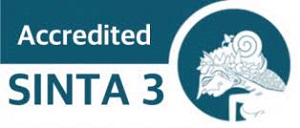ADDITIONAL MENU
Student Behavior Monitoring System in Classroom Environment Using YOLOv8
Abstract
Student ethics in an academic environment is an important element in creating an orderly and professional learning environment. One form of ethical violation that is still often found in the lecture environment is eating and drinking activities in the classroom. This study's objective is to develop an automatic detection system for unethical student behavior in the classroom, especially eating and drinking activities, utilizing one of the newest Real-time deep learning approaches object recognition on a Raspberry Pi device, The algorithm known as You Only Look Once version 8 (YOLOv8). A special dataset was developed through a manual annotation process in the form of images and videos showing students with various activities in the classroom. This system is expected to be an additional solution in monitoring student ethics automatically, efficiently, and in real-time in a modern learning environment. The test findings demonstrate that the model can identify eating and drinking activities with a respectable degree of precision indicating that the system is able to detect target activities with an accuracy level of up 95% with fairly stable performance in good lighting conditions and certain viewing angles
Keywords
Deep Learning; Object Detection; Raspberry Pi; Sudent Ethics; YOLO
Full Text:
PDFReferences
U. Handalage, L. Kuganandamurthy, and U. Hdi, “Real-Time Object Detection Using YOLO: A Review SEE PROFILE Real-Time Object Detection using YOLO: A review,” no. May, 2021, doi: 10.13140/RG.2.2.24367.66723.
G. Bannerjee, U. Sarkar, S. Das, and ..., “Artificial intelligence in agriculture: A literature survey,” Int. J. …, no. June, 2018, [Online]. Available: https://www.researchgate.net/profile/Gouravmoy-Banerjee/publication/326057794_Artificial_Intelligence_in_Agriculture_A_Literature_Survey/links/5b35ab970f7e9b0df5d83ec6/Artificial-Intelligence-in-Agriculture-A-Literature-Survey.pdf
D. J. Shin and J. J. Kim, “A Deep Learning Framework Performance Evaluation to Use YOLO in Nvidia Jetson Platform,” Appl. Sci., vol. 12, no. 8, 2022, doi: 10.3390/app12083734.
Y. Li, J. Wang, J. Huang, and Y. Li, “Research on Deep Learning Automatic Vehicle Recognition Algorithm Based on RES-YOLO Model,” Sensors, vol. 22, no. 10, 2022, doi: 10.3390/s22103783.
J. Redmon, S. Divvala, R. Girshick, and A. Farhadi, “You only look once: Unified, real-time object detection,” Proc. IEEE Comput. Soc. Conf. Comput. Vis. Pattern Recognit., vol. 2016-December, pp. 779–788, 2016, doi: 10.1109/CVPR.2016.91.
A. Bochkovskiy, C.-Y. Wang, and H.-Y. M. Liao, “YOLOv4: Optimal Speed and Accuracy of Object Detection,” 2020, [Online]. Available: http://arxiv.org/abs/2004.10934
J. Terven, D. M. Córdova-Esparza, and J. A. Romero-González, “A Comprehensive Review of YOLO Architectures in Computer Vision: From YOLOv1 to YOLOv8 and YOLO-NAS,” Mach. Learn. Knowl. Extr., vol. 5, no. 4, pp. 1680–1716, 2023, doi: 10.3390/make5040083.
Y. Cao, Q. Cao, C. Qian, and D. Chen, “YOLO-AMM: A Real-Time Classroom Behavior Detection Algorithm Based on Multi-Dimensional Feature Optimization,” Sensors, vol. 25, no. 4, pp. 1–21, 2025, doi: 10.3390/s25041142.
F. Yang, T. Wang, and X. Wang, “Student Classroom Behavior Detection Based on YOLOv7+BRA and Multi-model Fusion,” Lect. Notes Comput. Sci. (including Subser. Lect. Notes Artif. Intell. Lect. Notes Bioinformatics), vol. 14357 LNCS, pp. 41–52, 2023, doi: 10.1007/978-3-031-46311-2_4.
V. Viswanatha, R. K. Chandana, and A. C. Ramachandra, “IoT Based Smart Mirror Using Raspberry Pi 4 and YOLO Algorithm: A Novel Framework for Interactive Display,” Indian J. Sci. Technol., vol. 15, no. 39, pp. 2011–2020, 2022, doi: 10.17485/ijst/v15i39.1627.
S. Das, A. Dey, A. Pal, and N. Roy, “Applications of Artificial Intelligence in Machine Learning: Review and Prospect,” Int. J. Comput. Appl., vol. 115, no. 9, pp. 31–41, 2015, doi: 10.5120/20182-2402.
K. C. A. Khanzode and R. D. Sarode, “Advantages and Disadvantages of Artificial Intelligence and Machine Learning: A Literature Review,” Int. J. Libr. Inf. Sci., vol. 9, no. 1, pp. 9–10, 2020, [Online]. Available: http://www.iaeme.com/IJLIS/index.asp30http://www.iaeme.com/IJLIS/issues.asp?JType=IJLIS&VType=9&IType=1JournalImpactFactor%0Awww.jifactor.comhttp://www.iaeme.com/IJLIS/issues.asp?JType=IJLIS&VType=9&IType=1
A. Kish, “Machine Learning: A Review of Methods and Applications,” Researchgate.Net, vol. 10, no. 07, 2018, [Online]. Available: https://www.researchgate.net/profile/Adam-Kish-2/publication/327645425_Machine_Learning_A_Review_of_Methods_and_Applications/links/5b9b679a299bf13e602d5bcd/Machine-Learning-A-Review-of-Methods-and-Applications.pdf
X. Wang, H. Gao, Z. Jia, and Z. Li, “BL-YOLOv8: An Improved Road Defect Detection Model Based on YOLOv8,” Sensors (Basel)., vol. 23, no. 20, 2023, doi: 10.3390/s23208361.
S. A. Magalhães et al., “Evaluating the single-shot multibox detector and yolo deep learning models for the detection of tomatoes in a greenhouse,” Sensors, vol. 21, no. 10, pp. 1–24, 2021, doi: 10.3390/s21103569.
F. M. Talaat and H. ZainEldin, “An improved fire detection approach based on YOLO-v8 for smart cities,” Neural Comput. Appl., vol. 35, no. 28, pp. 20939–20954, 2023, doi: 10.1007/s00521-023-08809-1.
A. A. Rasjid, B. Rahmat, and A. N. Sihananto, “Implementasi YOLOv8 Pada Robot Deteksi Objek,” J. Technol. Syst. Inf., vol. 1, no. 3, p. 9, 2024, doi: 10.47134/jtsi.v1i3.2969.
Z. J. Khow, Y. F. Tan, H. A. Karim, and H. A. A. Rashid, “Improved YOLOv8 Model for a Comprehensive Approach to Object Detection and Distance Estimation,” IEEE Access, vol. 12, no. April, pp. 63754–63767, 2024, doi: 10.1109/ACCESS.2024.3396224.
G. Plastiras, C. Kyrkou, and T. Theocharides, “Efficient convnet-based object detection for unmanned aerial vehicles by selective tile processing,” ACM Int. Conf. Proceeding Ser., 2018, doi: 10.1145/3243394.3243692.
B. S. Rekha, A. Marium, G. N. Srinivasan, and S. A. Shetty, “Literature Survey on Object Detection using YOLO,” Int. Res. J. Eng. Technol., vol. 07, no. 06, pp. 3082–3088, 2020, [Online]. Available: https://www.irjet.net/archives/V7/i6/IRJET-V7I6576.pdf
J. Lee and K. il Hwang, “YOLO with adaptive frame control for real-time object detection applications,” Multimed. Tools Appl., vol. 81, no. 25, pp. 36375–36396, 2022, doi: 10.1007/s11042-021-11480-0.
A. Amperawan, D. Andika, M. Anisah, S. Rasyad, and P. Handayani, Confusion Matrix Using Yolo V3-Tiny on Quadruped Robot Based Raspberry PI 3B + . Atlantis Press International BV, 2024. doi: 10.2991/978-94-6463-386-3_56.
S. Sathyanarayanan and B. R. Tantri, “Confusion Matrix-Based Performance Evaluation Metrics,” no. December, 2024, doi: 10.53555/AJBR.v27i4S.4345.
I. P. Sary, S. Andromeda, and E. U. Armin, “Performance Comparison of YOLOv5 and YOLOv8 Architectures in Human Detection using Aerial Images,” Ultim. Comput. J. Sist. Komput., vol. 15, no. 1, pp. 8–13, 2023, doi: 10.31937/sk.v15i1.3204.
K. A. Philbrick et al., “RIL-Contour: a Medical Imaging Dataset Annotation Tool for and with Deep Learning,” J. Digit. Imaging, vol. 32, no. 4, pp. 571–581, 2019, doi: 10.1007/s10278-019-00232-0.
D. Valencia, E. Munoz Espana, and M. Munoz Anasco, “Impact of the preprocessing stage on the performance of offline automatic vehicle counting using YOLO,” IEEE Lat. Am. Trans. , vol. 22, no. 9, pp. 723–732, 2024, doi: 10.1109/TLA.2024.10669248.
DOI: http://dx.doi.org/10.24014/ijaidm.v8i2.37086
Refbacks
- There are currently no refbacks.
Office and Secretariat:
Big Data Research Centre
Puzzle Research Data Technology (Predatech)
Laboratory Building 1st Floor of Faculty of Science and Technology
UIN Sultan Syarif Kasim Riau
Jl. HR. Soebrantas KM. 18.5 No. 155 Pekanbaru Riau – 28293
Website: http://predatech.uin-suska.ac.id/ijaidm
Email: ijaidm@uin-suska.ac.id
e-Journal: http://ejournal.uin-suska.ac.id/index.php/ijaidm
Phone: 085275359942
Journal Indexing:
Google Scholar | ROAD | PKP Index | BASE | ESJI | General Impact Factor | Garuda | Moraref | One Search | Cite Factor | Crossref | WorldCat | Neliti | SINTA | Dimensions | ICI Index Copernicus
IJAIDM Stats










